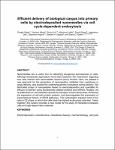Efficient Delivery of Biological Cargos into Primary Cells by Electrodeposited Nanoneedles via Cell-Cycle-Dependent Endocytosis
| dc.contributor.author | Wang, Z | |
| dc.contributor.author | Wang, H | |
| dc.contributor.author | Lin, S | |
| dc.contributor.author | Labib, Mahmoud | |
| dc.contributor.author | Ahmed, S | |
| dc.contributor.author | Das, J | |
| dc.contributor.author | Angers, S | |
| dc.contributor.author | Sargent, EH | |
| dc.contributor.author | Kelley, SO | |
| dc.date.accessioned | 2023-08-01T10:20:01Z | |
| dc.date.available | 2023-08-01T10:20:01Z | |
| dc.date.issued | 2023-07-12 | |
| dc.identifier.issn | 1530-6992 | |
| dc.identifier.issn | 1530-6992 | |
| dc.identifier.uri | https://pearl.plymouth.ac.uk/handle/10026.1/21117 | |
| dc.description.abstract |
Nanoneedles are a useful tool for delivering exogenous biomolecules to cells. Although therapeutic applications have been explored, the mechanism regarding how cells interact with nanoneedles remains poorly studied. Here, we present a new approach for the generation of nanoneedles, validated their usefulness in cargo delivery, and studied the underlying genetic modulators during delivery. We fabricated arrays of nanoneedles based on electrodeposition and quantified its efficacy of delivery using fluorescently labeled proteins and siRNAs. Notably, we revealed that our nanoneedles caused the disruption of cell membranes, enhanced the expression of cell–cell junction proteins, and downregulated the expression of transcriptional factors of NFκB pathways. This perturbation trapped most of the cells in G2 phase, in which the cells have the highest endocytosis activities. Taken together, this system provides a new model for the study of interactions between cells and high-aspect-ratio materials. | |
| dc.format.extent | 5877-5885 | |
| dc.format.medium | Print-Electronic | |
| dc.language | en | |
| dc.publisher | American Chemical Society | |
| dc.subject | Electrodeposition | |
| dc.subject | nanostructure | |
| dc.subject | intracellular delivery | |
| dc.subject | mechanobiology | |
| dc.subject | cell cycle | |
| dc.title | Efficient Delivery of Biological Cargos into Primary Cells by Electrodeposited Nanoneedles via Cell-Cycle-Dependent Endocytosis | |
| dc.type | journal-article | |
| dc.type | Journal Article | |
| dc.type | Research Support, Non-U.S. Gov't | |
| plymouth.author-url | https://www.webofscience.com/api/gateway?GWVersion=2&SrcApp=PARTNER_APP&SrcAuth=LinksAMR&KeyUT=WOS:000971993400001&DestLinkType=FullRecord&DestApp=ALL_WOS&UsrCustomerID=11bb513d99f797142bcfeffcc58ea008 | |
| plymouth.issue | 13 | |
| plymouth.volume | 23 | |
| plymouth.publication-status | Published | |
| plymouth.journal | Nano Letters | |
| dc.identifier.doi | 10.1021/acs.nanolett.2c05083 | |
| plymouth.organisational-group | |Plymouth | |
| plymouth.organisational-group | |Plymouth|Faculty of Health | |
| plymouth.organisational-group | |Plymouth|REF 2021 Researchers by UoA | |
| plymouth.organisational-group | |Plymouth|Users by role | |
| plymouth.organisational-group | |Plymouth|Users by role|Academics | |
| plymouth.organisational-group | |Plymouth|REF 2021 Researchers by UoA|UoA01 Clinical Medicine | |
| plymouth.organisational-group | |Plymouth|Faculty of Health|Peninsula Medical School | |
| dc.publisher.place | United States | |
| dcterms.dateAccepted | 2023-03-25 | |
| dc.date.updated | 2023-08-01T10:19:39Z | |
| dc.rights.embargodate | 2024-4-10 | |
| dc.identifier.eissn | 1530-6992 | |
| dc.rights.embargoperiod | forever | |
| rioxxterms.versionofrecord | 10.1021/acs.nanolett.2c05083 |


